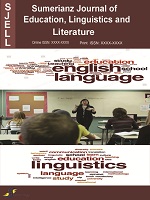Sumerianz Journal of Education, Linguistics and Literature

Online ISSN: 2617-1201
Print ISSN: 2617-1732
Quarterly Published (4 Issues Per Year)
Journal Website: https://www.sumerianz.com/?ic=journal-home&journal=33Archive
Volume 3 Issue 11 (2020)
An Overview of Itu Mbon Uso Consonants
Authors : Idongesit Edo ; Okokon Akpan
DOI : doi.org/10.47752/sjell.311.254.264
Abstract:This study attempts a systematic description and classification of Itu Mbon Uso Consonants, using a descriptive framework. This research will provide a background study for the description of Itu Mbon Uso consonants. It aims to establish and provide a detailed study of the consonant sounds available in the Itu Mbon Uso language. Data was collected through primary and secondary sources. The trial version of the Ibadan 400 wordlist was used in data collection. In addition, there was the need to develop short sentences in the language so as to capture the pronunciation of words not found in the 400 wordlist and to show the position of each segment in words. The objective of this research is the need to develop our indigenous languages and save them from extinction, which should begin with the development of the orthography. The study revealed that they are seventeen phonemic and twenty phonetic consonants in Itu Mbon Uso with syllabic features such as aspiration and consonant processes like nasalization and palatalization. Our contribution is the provision of the consonantal inventory of the language which will act as a springboard for the eventual development of orthography for the language. The study is also important documentation of an endangered language, which had hitherto received little attention. It is recommended that research be carried out on the vowel system of the language to ensure an eventual orthography for the language.
Differential Test let Functioning (DTLF) in Senior School Certificate Mathematics Examination Using Multilevel Measurement Modelling
Authors : Emily Oluseyi Adeyemo ; Oluwaseyi Aina Opesemowo
DOI : doi.org/10.47752/sjell.311.249.253
Abstract:The study determined the parameter estimate of the Senior School Certificate Mathematics items of June/July 2017 NECO examinations and testlet effect under Multilevel Measurement Modeling with the aim of providing information on the psychometric properties and quality of the items. The research design was an ex-post facto, The examinees response were the multiple – choice items of the National Examinations Council Mathematics paper two for June/July 2017 which consisted the data for the study group. The targeted population consisted of 26,086 senior secondary three examinees who registered for Mathematics Senior School Certificate (NECO) in June/July 2017 in Osun State. A total of 318 private schools and 179 public schools registered for the paper. The results revealed the following items to be good which implied that such items functioned well, these were: items 1, 4, 7, 8, 9, 10, 11, 12, 14, 15, 17, 18, 20, 21, 22, 23, 26, 27, 28, 29, 31, 32, 33, 34, 35, 36, 37, 40, 42, 43, 44, 45, 46, 47, 48, 50, 51, 52, 54, 57, 58, 59, 60 whereas items that were considered to be bad included 2, 3, 5, 6, 8, 13, 16, 19, 24, 25, 30, 38, 39, 41, 49, 53, 55 and 56. Furthermore, investigating an average bundle of item statistics under the measurement framework indicated that the Item Discrimination Means value and Standard Deviation under IRT approach were 1.26 and 0.60 respectively while the Mean value difference was 1.26. Although, item difficulty Mean value and the Standard Deviation were 0.26 and 4.26, respectively, whereas the Mean value difference was 0.26. Similarly, the guessing Mean value and the Standard Deviation were 0.15 and 0.19, respectively, whereas the Mean value difference stood at 0.15. The study concluded that any standardized examination, especially from an examining body in charge of certificate examination, if issues like differential testlet effect is not taking into consideration, it could harm the validity of the items and also alter the ability estimates of the examinees The validity of the test would be strengthened when issues like differential testlet effect is adequately taken care of.



